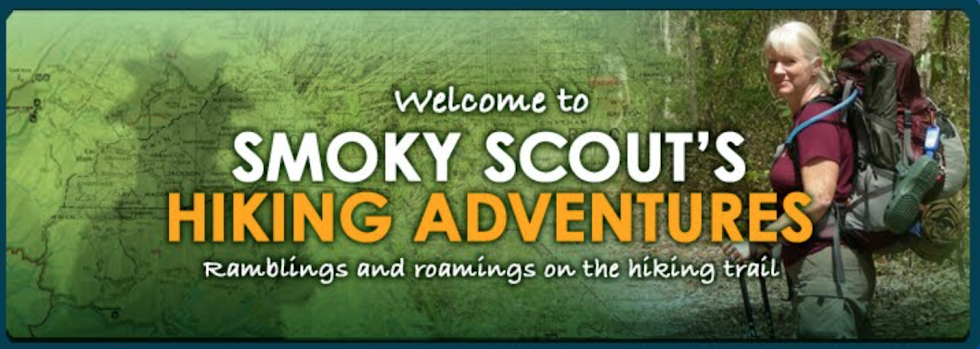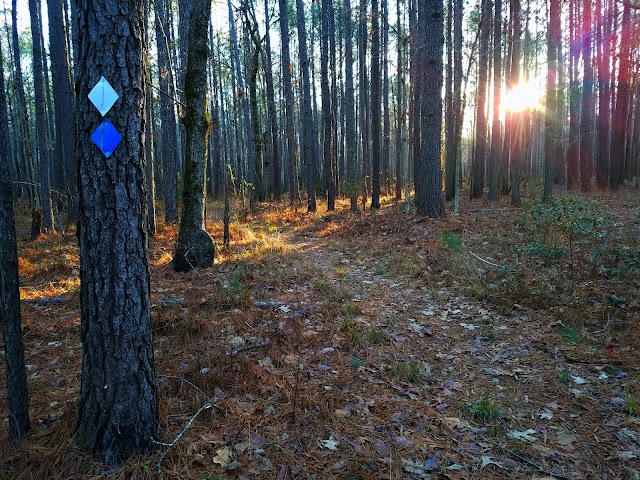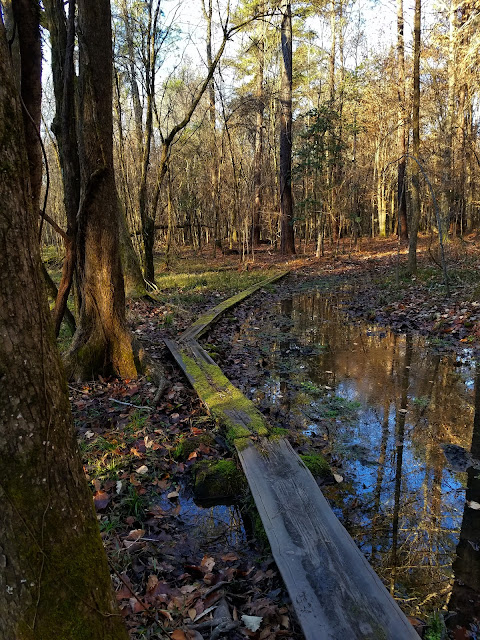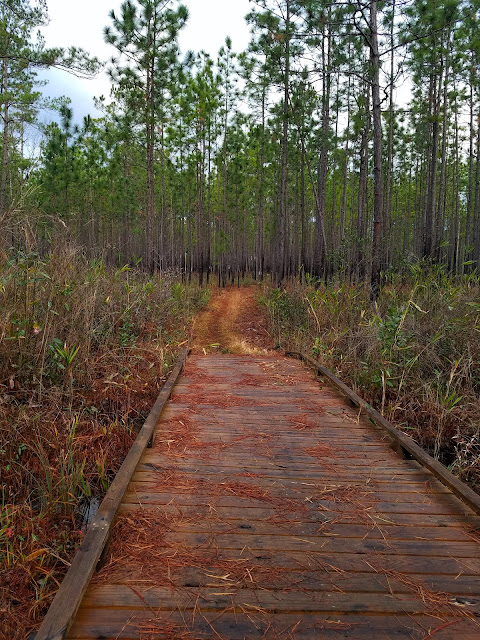Looks like 11 hours is my maximum tolerance for staying inside a tent. I slept well (can’t remember if I got up to pee?) but once again I was wide awake by 6:00 a.m. Carol was also stirring in her tent. Soon we were dressed and enjoying a cold breakfast in her car, because nobody wants to take off gloves to light a backpacking stove on a frigid morning. Carol had brought cold-brewed coffee from home and I was satisfied with yogurt and a Clif bar to get me started.
By 7:30 a.m. we were ready to move, anticipating a similar day on the Swamp Fox Trail. One difference, though, was the significant drop in temperature – a very cold start. My layered ensemble: short sleeve shirt, long sleeve lightweight shirt, quarter-zip Smartwool long sleeve, lightweight black fleece, puffy jacket, thick wool gloves, and a fleece headband under my Liberty hat. I skipped long underwear, opted for my rain pants. My legs are the first body parts to warm up and it's easy to get out of the rain pants. Carol wore a layered combo as well. [This was not our first chill rodeo.]
Still, it took quite a while for my fingers to warm up.
Today we hiked westbound again, from just before Mile 19 to Mile 33 at Cordeville Road where my car was (hopefully still) parked. For our first seven miles, the trail ran concurrently with the Jericho Horse Trail (it’s a 19-mile loop).
Creeks run everywhere through the Lowcountry, all heading to the coast, creating swamps and marshes. Creek names describe the wildlife, the terrain, sometimes the landowners and human occupants: Alligator Creek, Turkey Creek, Jericho Branch, Bullhead Run, Negro Field Branch.
Disclaimer: I have not researched extensively and can’t cite sources, but I’ve learned generally that rice plantations in Berkeley County (for example, Jericho and Windsor) used Jericho Swamp, Hell Hole Swamp, and others as primary water sources to cultivate their rice fields.
Our first three miles today followed Turkey Creek. The early morning light felt ethereal, created just for us. When you think about it, all of nature is created for anyone who is open to it.
The trail was a little wet to start but overall in better condition than yesterday, more muddy than deep water, some edge walking but less bushwhacking. Due to one more day of drying out?
Around Mile 22, still following Jericho Horse Trail, we emerged from the pines, crossed SC 41, and re-entered the forest. The trail made a 90-degree right turn to commence a 4-mile-long, perfectly straight path on a raised converted rail bed with swamps and water-filled ditches on either side. What at first seemed interesting and unusual became monotonous and never-ending. There was nary a dry place to take a discreet pee break.
We crossed numerous forest roads today, some multiple times, and I was grateful to have the GAIA app to keep oriented. [Note: Road names were also clues to local wildlife encounters: Yellow Jacket Road, Copperhead Road, etc.]
Past Mile 24 there was a dam-like crossing of Hell Hole Swamp, a wide raised concrete walkway bordered by granite boulders. We were looking for a sunny spot for a lunch break, so we stopped at the midpoint.
[The name “Hell Hole” is fun to say and capitalize on. Check out the Hell Hole Swamp Festival, 5K, parade and Miss Hell Hole Swamp Festival Beauty Pageant.]
A few hundred yards past the bridge (much closer than I thought it would be) we discovered the Nicholson Creek campsite with comfortable benches – haha! But we’d enjoyed sitting in the sun on the boulders at the dam.

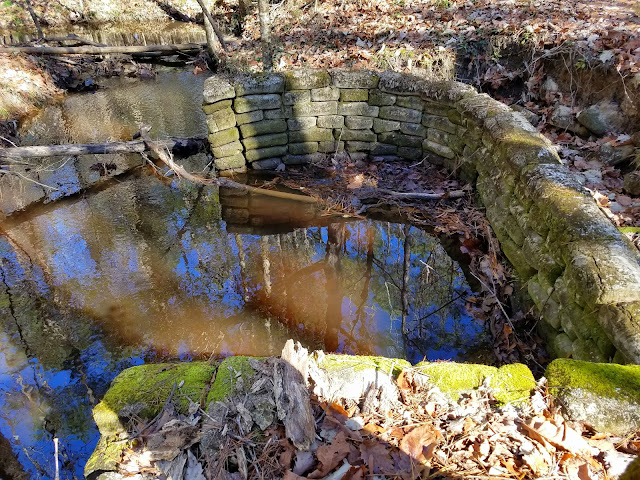 An intriguing stone structure with curved corners, looks like the foundation of a building,
An intriguing stone structure with curved corners, looks like the foundation of a building, haven’t found any info about this
At Mile 26, Swamp Fox Trail takes a sharp 45-degree left turn and parts ways with Jericho Horse Trail, crossing Witherbee Road and beginning another run of 4 relatively straight miles. We were closer than ever to civilization, walking behind homes, then past Witherbee Campground and across the CSX Rail Line. We also passed through Little Hellhole Reserve, a birding mecca of the Francis Marion National Forest.
The last two miles to my car at Cordeville (yay, it’s still there!) were soft pine needles and easy boardwalks.
We’re staying at Eccles Church again tonight. After our indulgent siesta, we moved my car to tomorrow’s campsite at Mile 6 on Halfway Creek Road, with the plan to hike eastbound from Eccles Church to there tomorrow. We’ll miss the quiet isolation of our little churchyard home!
Hmmm…significant rain is in the weather forecast after tomorrow. If the trail is already as wet as we’ve seen, do we want to walk the last 13 miles of it in the rain? We’ll discuss and decide as we hike tomorrow.
After placing my car, we returned to the church and settled in as the temperature plummeted with the sunset. Carol set out her stove to boil water for supper, commenting, “Geez, it’s only 5:20!” Combining backpacking with the luxury of car camping where you throw everything in the trunk “just in case,” we ate snacks from our generous stashes we’d brought while we made hot backpacker meals. Carol treated herself to hot chocolate and I sipped fruity hot tea, my end-of-day camping tradition.
Near dusk we noticed two glowing lights in the church cemetery – shall we investigate? I don’t know of anyone other than Carol that I would do that with without feeling apprehensive. Why? I guess I trust her – a lot!
We didn’t explore the back corners of the graveyard, but the front couple of rows looked very well cared for, with mementos left on the tombstones. The lights were solar lanterns that family members had left on two graves, one a simple light and the other one a glowing Jesus figure.
In our tents before 7:00 PM because it was cold, but I wasn’t worried about sleeping warm tonight because I’ve figured out the system. I’d brought an extra thick fleece blanket (car camping!) to pull over my sleeping bag. Even getting up to pee was okay because I could look forward to crawling back into the warm cocoon. Temp went down to 28 degrees.
“Enjoy the little things, for one day you may look back and realize they were the big things.”
~Robert Brault
